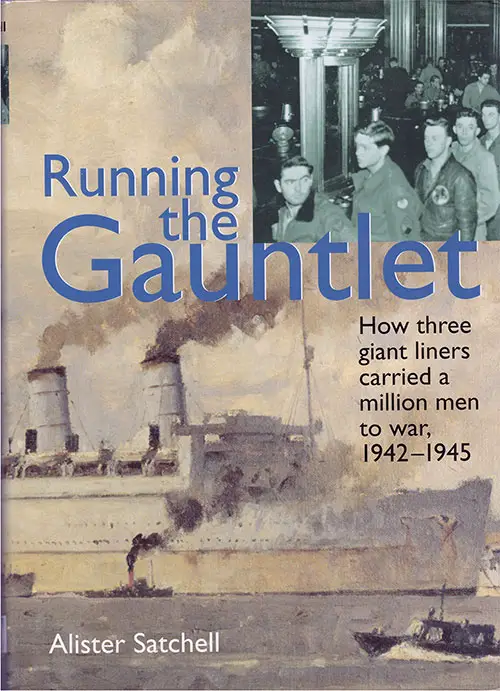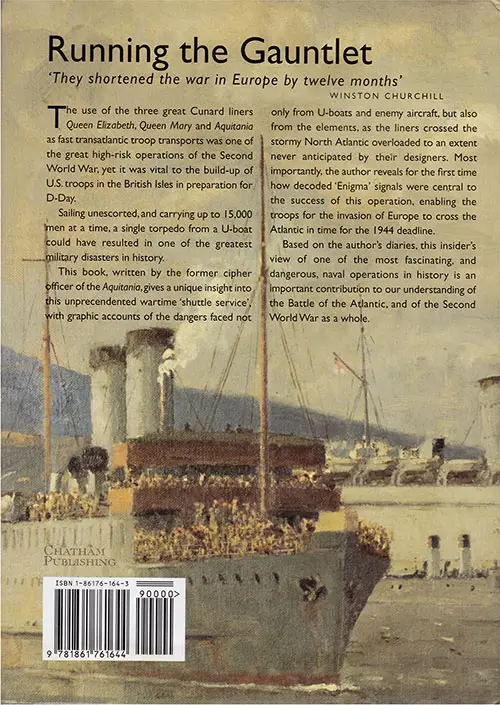Running the Gauntlet: How Three Giant Liners Carried a Million Men to War, 1942-1945

Front Cover, Running the Gauntlet: How Three Giant Liners Carried a Million Men to War, 1942-1945 by Alister Satchell, 2001. GGA Image ID # 17f7604ffc
2003 © Printed by Chatham Publishing London. ISBN-10: 1861761643 ISBN-13: 978-1861761644
Running the Gauntlet: How Three Giant Liners Carried a Million Men to War, the Cunard Liners Aquitania, Queen Mary and the Queen Elizabeth were used as troop transport ships. This is there story.
From the Back Cover
Running the Gauntlet
'They shortened the war in Europe by twelve months'
WINSTON CHURCHILL
The use of the three great Cunard liners Queen Elizabeth, Queen Mary and Aquitania as fast transatlantic troop transports was one of the great high-risk operations of the Second World War, yet it was vital to the build-up of U.S. troops in the British Isles in preparation for D-Day.
Sailing unescorted, and carrying up to 15,000 men at a time, a single torpedo from a U-boat could have resulted in one of the greatest military disasters in history.
This book, written by the former cipher officer of the Aquitania,gives a unique insight into his unprecedented wartime ‘shuttle service’, with graphic accounts of the dangers faced not only from U-boats and enemy aircraft, but also from the elements, as the liners crossed the stormy North Atlantic overloaded to an extent never anticipated by their designers.
Most importantly, the author reveals for the first time how decoded ‘Enigma’ signals were central to the success of this operation, enabling the troops for the invasion of Europe to cross the Atlantic in time for the 1944 deadline.
Based on the author’s diaries, this insider’s view of one of the most fascinating, and dangerous, naval operations in history is an important contribution to our understanding of the Battle of the Atlantic, and of the Second World War as a whole.

Back Cover, Running the Gauntlet: How Three Giant Liners Carried a Million Men to War, 1942-1945 by Alister Satchell, 2001. GGA Image ID # 17f76b7bdb
Excerpt from the Introduction
The most rapid and highly organized transportation of troops in history was underway by the latter months of 1942 following the entry of the United States into the Second World War in December 1941.
Britain, from where the principal invasion of Europe would be launched, became the destination for the greatest number of soldiers, airmen and women of the auxiliary services, and the central theme of this book is the carriage by sea of United States and British Umpire troops from North America to the Clyde Estuary in Scotland.
The author, a lieutenant in the Royal Australian Navy Volunteer Reserve, was one of the two cipher officers in the 46,000-ton Cunard White Star liner Aquitania between March 1943 and July 1945.
He sailed in all the ship’s fifty-three Atlantic crossings between New York. Halifax or Boston, and Scotland, spending 395 days at sea. Shipboard knowledge of the daily strategic situation was confined to the captain, cipher officers, gunnery and bridge officers. Cipher officers attended pre-sailing conferences.
The author, technically in breach of 'King's Regulations and Admiralty Instructions’, kept personal diaries. locked in the safe with the ciphers, and these records proved to be invaluable in guiding this work.
In addition to the Aquitania. Cunard owned and operated the Queen Mary and the Queen Elizabeth. Sailing independently, as distinct from in convoy, these three ships formed the nucleus of an ‘Atlantic shuttle service’.
President Truman, in a ’Message to Congress’ on 2 June 1945, referred to them as ’Britain's three proudest liners', and British Prime Minister Sir Winston Churchill estimated the contribution of the Cunarders to the movement of troops shortened the war in Europe by twelve months.
Between mid-1942 and May 1945, some 4 1/2 million United Slates personnel set out to cross the Atlantic from the ports of New York. Boston. Hampton Roads and Charleston, with New York contributing 75 percent of the total.
Canadian, Australian and New Zealand forces embarking also from Canadian and U S. ports, raised the overall number to well in excess of 5 million.
Dustjacket Illustrations
Main: Detail of a painting by Norman Wilkinson showing the Queen Mary at Gourock.
(Courtesy The Board of Trustees of the National Museums and Galleries on Merseyside - Merseyside Maritime Museum).
Inset: GIs queuing in Queen Mary's first class restaurant.
(Courtesy the Imperial War Museum, London)
Contents
- Acknowledgements
- Introduction
- Prologue
- Chapter 1: The ‘Grand Hotels’ of the North Atlantic
- Chapter 2: The Giant Cunarders Before the Shuttle Begins
- Chapter 3: The Atlantic Battle - The Early Years
- Chapter 4: An Introduction to Seafaring
- Chapter 5: The Logistics of the Eastward Crossing
- Chapter 6: May 1943 - Not a Merry Month
- Chapter 7: London - Then Westward Bound
- Chapter 8: New York, New York was a Wonderful Town
- Chapter 9: The ‘Race against Time’ Accelerates
- Chapter 10: New German Naval Technologies Bring Allied Response
- Chapter 11: The Winter of 1943-1944 - The Stormiest in Memory
- Chapter 12: The Hectic Months Preceding D-Day
- Chapter 13: A Boston Refit Allows Travel Opportunities
- Chapter 14: The Invasion - U-Boats Flee the French Atlantic Ports
- Chapter 15: Surface Escorts in UK Waters
- Chapter 16: U-Boats Change Tactics -The Shuttle Presses On
- Chapter 17: The Final Weeks
- Chapter 18: Reflections
- Epilogue
- Bibliography
- Index
About the Author
Allster Satchell volunteered to join the Royal Australian Navy in 1940 following the German invasion of the Low Countries. He served in Naval Headquarters in Melbourne as a cipher officer from early 1941, from where his appointment to the Aquitania was made in March 1943.
After the war, he practiced as a fire loss adjuster, and now lives in retirement in Melbourne.
Library of Congress Catalog Listing
- LC Control No.: 00111312
- Type of Material: Book (Print, Microform, Electronic, etc.)
- Personal Name: Satchell, Alister.
- Main Title: Running the gauntlet : how three giant liners carried a million men to war, 1942-1945 / Alister Satchell.
- Published/Created: Annapolis, Md. : Naval Institute Press, c2001.
- Description: 256 p. : ill., maps; 24 cm.
- ISBN: 1557509743
- Notes: Includes bibliographical references (p. [249]-250) and index.
- Subjects: Satchell, Alister. Aquitania (Steamship). Queen Mary (Steamship). Queen Elizabeth (Ship). United States. Army --Transportation --History --20th century. World War, 1939-1945 --Transportation --Great Britain. World War, 1939-1945 --Naval operations, British. World War, 1939-1945 --Personal narratives, British. Ocean liners --Great Britain --History.
- LC Classification: D810.T8 S265 2001
- Dewey Class No.: 940.54/293 22
- Geographic Area Code: e-uk--- n-us---
- Quality Code: pcc
